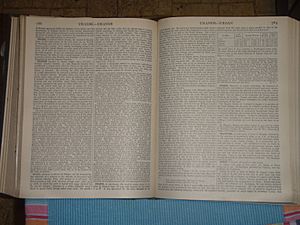Tertiary source facts for kids
A tertiary source is like a helpful guide that points you to other information. Think of it as a map to find primary and secondary sources. These sources give you a quick summary of a topic. They are great for getting started with research. You can use them to find good words for searching online. However, for big school projects, you'll usually need to use primary or secondary sources.
Contents
What are Tertiary Sources?
Common Examples
Some common examples of tertiary sources are encyclopedias and dictionaries.
- Encyclopedias: These are useful for getting a general idea about a subject. They are a good starting point for your research. Encyclopedias help you quickly understand new topics. But they usually don't have all the small details. As you learn more, you should use secondary or primary sources instead.
- Dictionaries: These give you definitions of words. They help you understand terms quickly.
- Almanacs and Fact Books: These often contain collections of facts and statistics. They can be tertiary sources.
- Handbooks and Manuals: Some of these can also be tertiary sources. They often summarize information.
How They Help You Research
Tertiary sources are super useful for finding search terms. They help you discover keywords for online searches. They give you a broad overview of a topic. This helps you decide if you want to learn more.
Primary, Secondary, or Tertiary?
It can sometimes be tricky to tell the difference. This depends on what you are studying.
- Primary Source: This is the original information. It's like the raw data or a firsthand account. For example, a diary or a scientific experiment's results.
- Secondary Source: This source talks about primary sources. It includes someone's explanation, analysis, or commentary on the original information. A history book is a good example.
- Tertiary Source: This is the furthest from the original research. Its main goal is to give a general introduction to a topic. It often summarizes both primary and secondary sources.
Think about how "close" the source is to the original event or idea. Tertiary sources are usually the "furthest away." In many school subjects, you won't use tertiary sources for your main research. They are best for starting out.
Related pages
- Primary source
- Secondary source
- Research
- Source text
See also
 In Spanish: Fuente terciaria para niños
In Spanish: Fuente terciaria para niños


